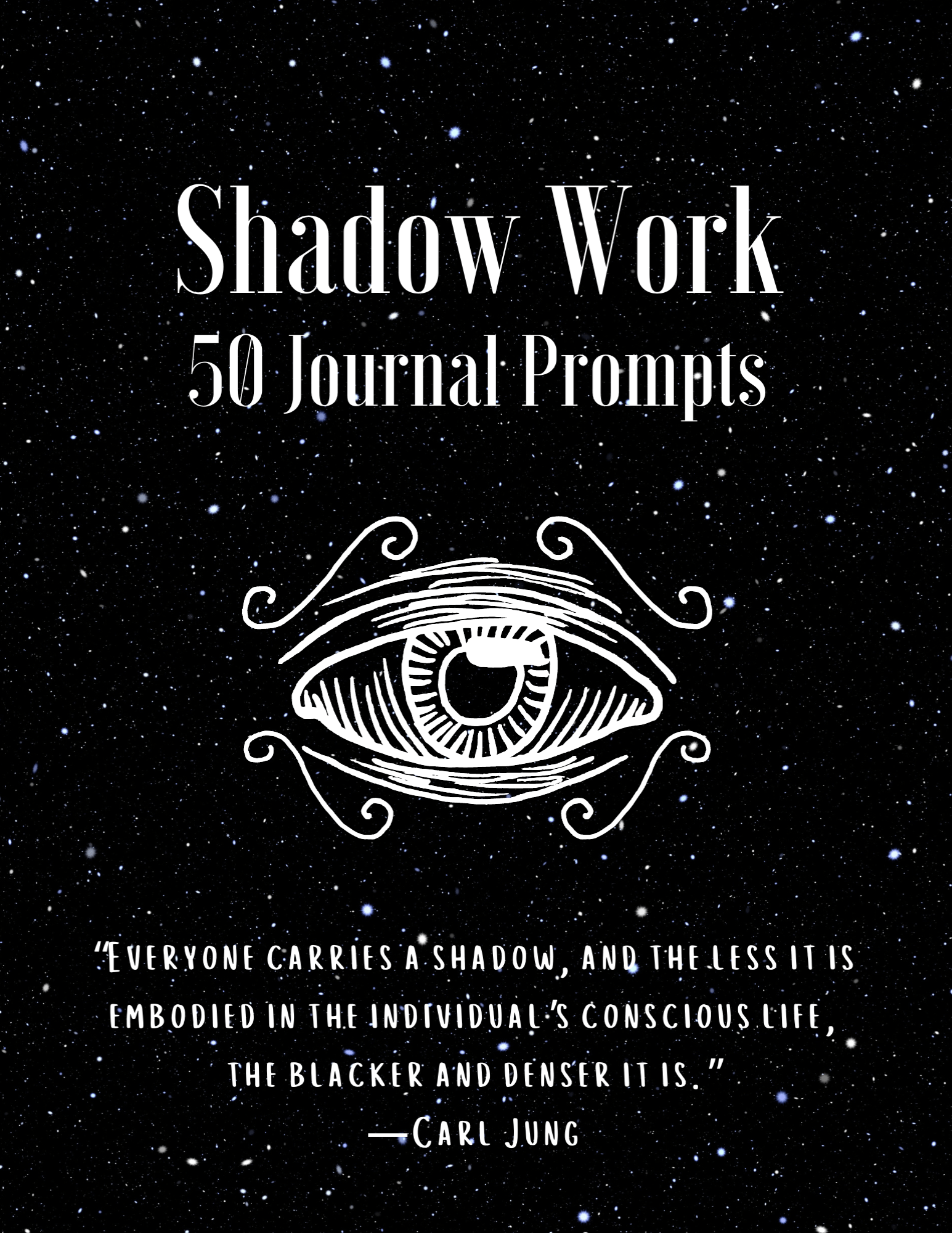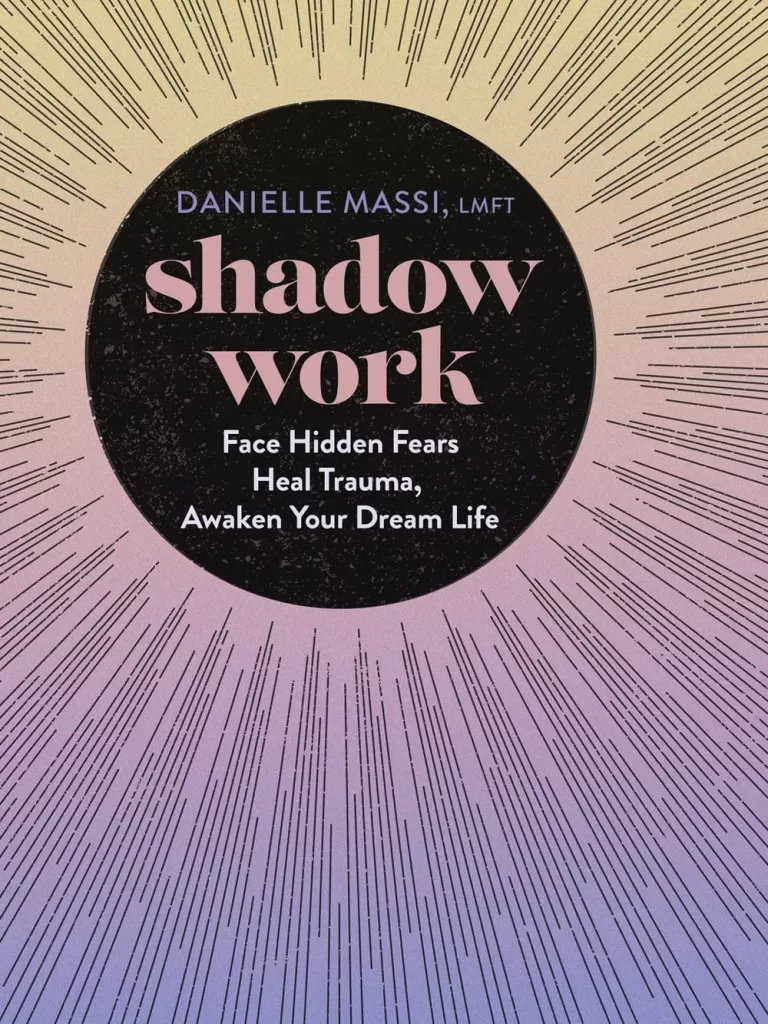Last Updated on September 24, 2023

Do you know the hidden motivations that drive your actions? Do you reject or suppress certain parts of yourself out of shame or even fear? Do you project your insecurities onto other people?
For many people, the answers to these questions are mixed. You may have confidence in your main character traits and can easily list the roles in your public and private lives. Yet, you know that there is more hidden under the surface, and if you could only bring these parts into the light, you would have access to so much more joy, power, and purpose.
In today’s post, you’ll discover what shadow work really is and its importance, 7 ways to spot your shadow self, and how to do shadow work for beginners.
What Is the Shadow?
“Everyone carries a shadow, and the less it is embodied in the individual’s conscious life, the blacker and denser it is.” — Carl Jung
According to Carl Jung’s analytical psychology, the shadow represents the “dark side” of your personality. The shadow self is the unknown part of you, it’s the psychological term for all the things you can’t or won’t see in yourself. However, the shadow is not bad, it’s just hidden. And because it is hidden, it runs around without supervision, often causing damage and pain in your life. The shadow may appear as rage, jealousy, hatred, greed, and selfishness, and it affects every aspect of your life. However, when you bring the shadow into the light, it no longer has power over you.
Everyone has a shadow self. The shadow gets developed in our childhood from our ego while adapting to social norms. We learn to change and adapt our behavior in a way that is acceptable in society. But along the way, we also bury an authentic part of ourselves, our shadow side…
What Is Shadow Work?
The idea of shadow work is to bring your dark sides out into the light and learn to accept and love them. There are different exercises and activities to help explore those aspects of yourself, but you must first acknowledge your shadow. We will get more into this later in the post, so keep reading!
“The Shadow has power precisely because it remains in the dark; we tend to deny its presence because we consider it unacceptable. Only when we face and acknowledge the Shadow’s presence can we neutralize its potential negative impact on us.” — Caroline Myss
Is Shadow Work Dangerous?
Shadow work is not dangerous, even though it might sound frightening to jump into. It can be both scary and painful, but the shadow is a part of yourself that will actually cause more damage if it’s left in the dark…
However, many people tend to avoid engaging in shadow work, because it means they have to confront the dark part of themselves they rather not know about or want to admit.
Why Is Shadow Work Important?
The problem with the shadow sides of ourselves is that they have a deep and quiet, often negative impact on the way we behave, interact with others, and experience our lives.
It’s so important to find your shadow and bring it to light through shadow work. If not, you’ll end up with different issues, as a direct link from keeping your shadow in the dark.
One of the most important mechanisms caused by our shadows is projection. What we are not willing to accept within ourselves, we project onto other people. This is a problem for so many people, without even knowing it’s happening.
Some other common issues a hidden shadow can bring are manipulation, anger outbursts, greed, addictions, self-sabotage, racism/sexism/homophobia, anxiety, depression, and narcissism.
Benefits of Shadow Work
Shadow work is necessary if you wish to grow spiritually and personally. It will help you better understand yourself, your traumas, and the old wounds you are carrying. Not to mention, help you better understand other people.
Other benefits include:
- Help find your purpose in life.
- More courage to face the unknown.
- More confidence to be your true self.
- Deeper love, acceptance, and understanding of yourself.
- Improved relationships with others.
- Increased empathy and compassion.
- Better mental and psychical health.
- A clearer perception of the world.
- Increased creativity.
- Awareness of toxic patterns you are repeating, so you can change them.
- Help you find the root cause of your problems and traumas.
7 Ways to Spot Your Shadow Self
As your shadow self is deeply hidden within yourself it can be hard to spot. At least if you don’t know what to look for.
Here are seven ways that reveal your shadow self:
- You project unwanted feelings and traits onto others.
- You judge and criticize others.
- You are quick to temper and react to certain situations.
- You play the victim.
- You lack boundaries and have a hard time saying no.
- You have repetitive, addictive behavior.
- You deny feeling certain emotions.
How to Do Shadow Work for Beginners
The first step in shadow work is to acknowledge that you actually have a shadow side. We might not like to admit our bad sides, but we all have them!
Below are seven powerful shadow work exercises to try, these will also help discover your shadow self if it’s still hidden.
1. Observe Your Emotional Reaction
Pay attention to how you react to certain people, situations, and experiences. You must discover what triggers you, and what makes you react a certain way. Our triggers come from unrecognized patterns from our shadow selves.
Through mindfulness and self-observation you will start to recognize your emotions. And, the more self-aware you are, the easier it is to recognize your triggers and why you react a certain way.
Try to analyze specific episodes where you reacted strongly.
- Why did you react the way you did?
- How did it make you feel emotionally?
- Can you notice a pattern?
- Can you connect these episodes to something that happen once you were a child?
SEE ALSO:
2. Recreate Your Dreams
Every morning when you wake up, write down your dreams from the night. Try to remember as much as possible, including characters, colors, scents, sounds, emotions, situations, and so on. The more you recall, the better!
Then you should enter into an imaginary dialogue with the most important characters from the dream. Speak to the characters in the first person, and then respond like yourself.
The idea of this exercise is to become aware of the repressed part of ourselves. In our dreams, we encounter many unpleasant aspects and dark characters from life, which we may avoid in real life. The dark and unpleasant characters can be a direct representation of our shadow self, the side of ourselves we won’t acknowledge. In other words, the monster in your dream is a version of you!
3. Discover Your Shadow Archetype
By discovering your shadow archetype you will receive a greater understanding of why you react a certain way. Not to mention, a better understanding of other people and how to connect with them.
The 12 shadow archetypes include:
- The ruler – power-sick, egocentric, has a lot of pride, chases money and success, engages in destructive behaviors
- The caregiver – plays the victim, problems saying no, guilt-tripping, and feelings of inadequacy which leads to anger and frustration
- The everyman – manipulative, afraid to be left out, co-dependent, helpless, wants to fit in, lost sense of identity
- The creator – perfectionist, lacks stability and comfort, hard to accept things for how they are, not in control of their emotions
- The innocent – lack responsibility, inclined to follow and obey, ignore reality, naivety, blame other people
- The explorer – feeling lost and unfulfilled, danger-seeker, prone to addiction, search for excitement, restlessness, moves from one thing to another
- The warrior – creates chaos, never learns their lesson, stays stuck in unwanted situations, is immature, dependent on others to make their decisions, stays in the comfort zone, wild and reckless
- The outlaw – the same shadow traits as the warrior, complains rather than change
- The magician – detached, feeling unsatisfied with what they got, overly critical, paranoid, skeptic
- The lover – not in touch with their feelings, lacks self-love, prone to addiction, destructive behaviors, struggles to form relationships, obsessive and dependent on someone or something
- The jester – dishonest with themselves, trapped emotions, immature, annoying, self-sabotaging behavior
- The sage – obstinate, opinionated, impossible to reason with, loner, arrogant
4. Have a Dialogue With Your Shadow
In the evening, find a quiet place and reflect on the day that is over. You should focus on the people you have been in contact with during the day. Then, try to think about the people who in one way or another stood out. Think about a specific episode during the day you reacted strongly and possibly got upset or annoyed with that person.
Once you have found the person, start an imaginary dialogue with that person. You have to take the perspective of the other and then respond as yourself.
This shadow exercise will help us see all the aspects we do not acknowledge of ourselves and are often projecting onto others. When we deepen our understanding of how other people irritate or frighten us, it’s possible to discover the unknown aspects of ourselves.
5. Meditate
Through meditation, we can dive into the unconscious part of our brain. It calms our conscious mind, allowing us to get in touch with what lies beneath.
Things you have repressed or chosen to overlook will come up to the surface. That can frighten many beginner practitioners, wondering why their minds are more noisy and anxious. However, the truth is that all the noise and anxiety were already there. The difference is just the fewer distractions which makes you see them too clearly. You are meeting and freeing your shadow!
A great practice to try is Pranayama meditation. It’s a special breathing technique from the yogic tradition. There exist several Pranayama exercises, and one in particular to try is “square breathing”.
Do as following:
- Breathe in, while counting four seconds
- Hold your breath for four seconds
- Breathe out for four seconds
- Hold empty for four seconds
Do this twelve times, and your mind will be transported to another state!
See also: How to meditate for beginners + tips & tricks
6. Keep a Journal
Writing can be very therapeutic, sometimes it can be easier to put our words down on paper. And, by journaling, you can develop self-awareness and discover unhealthy patterns in your life.
Here are some spiritual shadow work questions to help you get started:
- In what parts of my life am I struggling the most?
- Are there any patterns that keep appearing?
- What emotions am I trying to avoid?
- What specific situations trigger me?
- What are some traumatic experiences that happened in my childhood? And, how has it affected me long-term?
- How am I projecting my insecurities onto other people?
- What is my worst side?
- How do other people see me? Think about three specific people close to you, and write down how you think they would describe you.
- Do I hold any grudges? If so, with who, and why?
As you write, try not to think so much. Instead, just write down whatever pops into your head. By doing that, you are accessing your shadow self and can more easily discover your struggles and connect the dots.
If you want more shadow work journal prompts, check out the Printable Shadow Work Journal with 50 powerful prompts that I created!

A printable shadow work journal for beginners to help bring your shadow out into the light. The journal prompts will open the doors to understanding yourself better, including your patterns, traumas, and the old wounds you are carrying so you can begin healing.
7. Practice Inner Child Work
Since our shadow selves are created in our childhood, it can be a good idea to get to know and start healing our inner child. The best way to do that is through inner child work. Check out my post on how to heal your inner child and powerful journal prompts for inner child healing.
Do you want more shadow work exercises, check out the 7-day shadow work challenge for healing!
The Shadow Work Course
Caroline Myss and Andrew Harvey, two of the most pioneering spiritual teachers and “shadow busters” of our time, were shocked by the unconsciousness of today’s world, so they decided to join forces to create The Shadow Course. This is an eight-week transformative learning experience that will truly change your life. Think of it as a guide to discovering what you don’t know so that you can align with your true power and purpose.
Of course, it is not easy to see what we don’t want to see about ourselves. We reject certain truths for a reason, and our greatest inner wealth is often hidden. The shadow course provides a journey of self-confrontation, one that requires courage, truth-telling, and willingness to grow. Caroline and Andrew called it “a holy adventure.”
In Shadow Work, you’ll explore how to uncover the hidden parts of yourself and see the secret forces at play in the world. You’ll learn to:
- Heal and transform the parts of yourself that keep causing the same negative patterns
- Reveal your hidden archetypes and better understand their connection to the Shadow
- Unearth new strengths, insights, and wisdom—there’s buried treasure in the Shadow too
- See our collective shadows and break free from the systems that keep you docile and disempowered
- Step into your sacred calling and make a difference in a world that needs you now
When you commit to the Shadow Work Online Course, you become fully empowered to create a life of purpose, joy, and meaning.
Now is the time to fully know yourself and bring your light to the world.
Books On Shadow Work



If you enjoyed this post on what shadow work is and how to do it, I would be very grateful if you spread the word by sharing it on Twitter, Facebook, or Pinterest! Thank you!❤️
📌 PIN THIS POST FOR LATER


Hello, my name is Sara and I am the founder of Spiritvibez, I’m here to guide you on your spiritual journey toward healing, growth, and self-discovery. I believe that true transformation occurs when the mind, body, and spirit are aligned and working in harmony. Through Spiritvibez, I hope to inspire and empower you to deepen your spiritual practice, embrace your authentic self, and begin living your best life.

Nice. Thankyou 🙂
Your welcome 🙂
This is very interesting about shadow work. That’s a great reason to get to a course for this work.
I’m happy you found shadow work interesting 🙂
It would be helpful and encouraging to also list the positive sideshow the archetypes.
Thank you for the feedback, I appreciate it. I will try to include it when I have the time 🙂
Thank you Sara for the Fascinating information! In all my year’s(50+) of seeing psychologist and psychiatrist l’ve never heard of “Shadow Work”. I will utilize the information and will also provide to others.
You’re welcome! I’m glad you found the information on Shadow Work to be fascinating. It can be a powerful tool for personal growth and self-discovery. I hope you find it helpful and that it brings you valuable insights.
Wow. I just finished reading “Codependent No More” and was exploring journal prompts for self-discovery. One of my daughters mentioned “Shadow Work”. Today I searched for this term to try and understand what it meant and found your article. So timely! So helpful. So what I needed in this EXACT moment. Thank you!!
Thank you for your comment! I’m so glad to hear that my article on shadow work was helpful to you and came at the right time 🙂
So happy I found this, and thanks for the Shadow work course link, my first response is ” I need that “
You are welcome, im glad to hear your liked the article and the shadow work course link 🙂